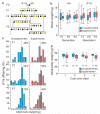Methyl donor supplementation prevents transgenerational amplification of obesity
- PMID: 18626486
- PMCID: PMC2574783
- DOI: 10.1038/ijo.2008.100
Methyl donor supplementation prevents transgenerational amplification of obesity
Abstract
Background: The obesity epidemic, recognized in developed nations for decades, is now a worldwide phenomenon. All age groups are affected, including women of childbearing age, fueling concern that maternal obesity before and during pregnancy and lactation impairs developmental establishment of body weight regulatory mechanisms in the fetus or infant, causing transgenerational amplification of obesity prevalence and severity. The biological mechanisms underlying such processes remain unknown.
Methods: We used agouti viable yellow (A(vy)) mice to test the hypothesis that maternal obesity induces transgenerational amplification of obesity. We passed the A(vy) allele through three generations of A(vy)/a females and assessed cumulative effects on coat color and body weight. By studying two separate but contemporaneous populations of mice, one provided a standard diet and the other a methyl-supplemented diet that induces DNA hypermethylation during development, we tested whether potential transgenerational effects on body weight might be mediated by alterations in epigenetic mechanisms including DNA methylation.
Results: The genetic tendency for obesity in A(vy) mice was progressively exacerbated when the A(vy) allele was passed through successive generations of obese A(vy) females. This transgenerational amplification of body weight was prevented by a promethylation dietary supplement. Importantly, the effect of methyl supplementation on body weight was independent of epigenetic changes at the A(vy) locus, indicating this model may have direct relevance to human transgenerational obesity.
Conclusion: Our results show that in a population with a genetic tendency for obesity, effects of maternal obesity accumulate over successive generations to shift the population distribution toward increased adult body weight, and suggest that epigenetic mechanisms are involved in this process.
Figures




References
-
- Lawlor DA, Smith GD, O’Callaghan M, Alati R, Mamun AA, Williams GM, et al. Epidemiologic evidence for the fetal over-nutrition hypothesis: findings from the mater-university study of pregnancy and its outcomes. Am J Epidemiol. 2007;165:418–424. - PubMed
-
- Levin BE. The obesity epidemic: metabolic imprinting on genetically susceptible neural circuits. Obes Res. 2000;8:342–347. - PubMed
-
- Darnton-Hill I, Nishida C, James WP. A life course approach to diet, nutrition and the prevention of chronic diseases. Public Health Nutr. 2004;7:101–121. - PubMed
-
- Keith SW, Redden DT, Katzmarzyk PT, Boggiano MM, Hanlon EC, Benca RM, et al. Putative contributors to the secular increase in obesity: exploring the roads less traveled. Int J Obes (Lond) 2006;30:1585–1594. - PubMed
-
- Kral JG, Biron S, Simard S, Hould FS, Lebel S, Marceau S, et al. Large maternal weight loss from obesity surgery prevents transmission of obesity to children who were followed for 2 to 18 years. Pediatrics. 2006;118:e1644–e1649. - PubMed
Publication types
MeSH terms
Substances
Grants and funding
LinkOut - more resources
Full Text Sources
Other Literature Sources
Medical

